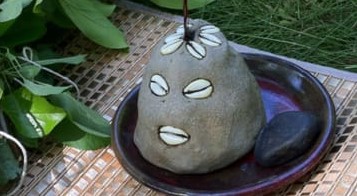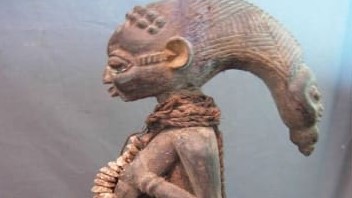All About Eshun: Learn who he is, how to address him, what you can ask of him, how to receive him, what paths he has, and what his treatise is.
The customs and rituals of different religions come from ancient roots. That’s why it’s important to understand all the aspects that govern each religion, such as the Yoruba religion, which, in addition to originating in Africa, has been nourished by others like the Catholic religion.
This union of beliefs, this taking common elements and transforming them into an autonomous force, requires a great deal of knowledge to understand where a particular element comes from, as well as how it has been enriched over time.
Who is Eshu?
Eshu is an entity from the group of Orisha Oddé, known as “The Warriors,” who are characterized by governing the manifestation of evil. The word Eshu means “sphere,” so it represents permanent movement.
Eshu is the exclusive domain of the babalawos, although “he does not sit on anyone’s head, so he does not settle.” He is one of the most influential deities, as no initiation takes place without Eshu being present.
Where is he from?

Eshu is “the first differentiated particle of life created by olorun.” It is said that his parents, Orula and his wife, wanted to have a child but were unable to, so they decided to turn to Obbatala for help.
Obbatala told them they should place their hands on the image for 12 months, after which the child did indeed come to life. His parents named him Eshu, but he soon learned that all was not well, as he ate everything in his path.
Where does he live?
In Yoruba tradition, Eshu is known to be found behind the door of the house, as well as at crossroads. He is said to live alone in inhospitable places, in the savannahs or the mountains.
It is also known that Eshu lives behind the door of the house, in a clay dish where offerings are placed. Eshu lives inside a clay pot called a freidera, which is placed behind the door of the house.
His mere presence prevents witchcraft or disturbances that disturb the peace of the family.
How do you attend to Eshu?

To know how to attend to Eshu, you need to understand that Eshu is the first saint to be attended to because he is Orula’s messenger and trusted saint.
- He can be attended on Mondays.
- Greetings are required.
- A white candle is lit, which should be placed on the floor next to the saint.
- Aguardiente is blown on it, and a cigar can also be lit.
The cigar is smoked halfway through and the rest is left for him. Among the offerings that can be made to Eshu are:
Fruits such as guava, as well as:
- Coconut.
- Yam.
- Corn.
- Coffee.
- Rooster.
- Chicken.
- Goat.
- Aguardiente and cigars.
On the third day, these ingredients should be thrown away. Honey should not be added because there are no sweet “Warriors.”
Note: Since Eshu is the one who opens and closes the paths, he should be fed frequently. This keeps the good paths open and the bad ones closed when working with Eshu.
How to pray to Eshu?
To pray to this Yoruba deity, it is advisable to do so with character so that Eshu hears the prayers. There are also some details that should be taken into account when praying to him. We explain them here.
- Do not kneel.
- Touch the floor 3 times with your left hand.
Prayer to attend to Eshu:
“Eshu here is (Name and surname) offering him moforibale so that he may help me and always keep the good paths open and the bad paths closed, for good health, development, happiness, stability, family unity, and wisdom, both for me and for my family, both blood and religious.”
The prayers offered must be in accordance with what is being asked, so they must be relevant to each occasion or situation of the person invoking him or offering him a job.
Why do we receive Eshu?
Although Eshu is neither an Orisha nor Elegua, we must show him the utmost respect, as this will help us divert negative influences from our lives.
We receive Eshu because it represents complementary balance, specifically in the Elegua-Eshu duality. Since there is no light without darkness, these deities represent the balance of good and evil.
What paths does he have?
According to various interpretations, it can be said that Eshu has 201 paths, although some say there are 121 paths classified according to 7 categories. Here are some of them:
- Eshu Abalonke.
- Eshu Abainukue [Abanulue].
- Eshu Abarikoko [Aberekoko].
- Eshu Aberu.
- Eshu Aboni.
- Eshu Adawa.
- Eshu Afradi.
- Eshu Aganika.
- Eshu Agbadé.
- Eshu Agbalonké.
- Eshu Agbanile.
- Eshu Agbobamaleki [Agbobara Meleki].
- Eshu Agongo Olo Onya.
- Eshu Agongo Ogo.
- Eshu Agogo [Agoto].
- Eshu Agomeyo.
- Eshu Agororó [Agoggoro].
- Eshu Agroiele [Agroi].
- Eshu Aiyede.
- Eshu Akarajéu.
- Eshu Akanadrede.
- Eshu Akere [Aguere].
- Eshu Akerebioke [Arerebieke].
- Eshu Akokolebiye [Akokoleriyu] [Akokoriye].
- Eshu Alagbóna [Alagbana] [Alagbawana].
- Eshu Alaloilu [Alalombe].
- Eshu Alaketu.
- Eshu Alawana.
- Eshu Alayiki.
- Eshu Aletán.
In any case, of the more than 100 trails, it is said that only about 30 are the best known.
What are the types of Eshu?
It is known that there are different types of Eshu, and they are represented by the Yangui stone. Among the types of Eshu are the following:
- Eshu Odara: the one who carries a sacrifice to heaven.
- Eshu Apede: the one who assists in divination and the work performed by the priest.
- Eshu Awure: the one who helps with luck.
- Eshu Alaje: the one who helps with wealth.
- Eshu Ogo: also used to bring luck and health.
- Eshu Iya: the one who fights enemies.
What is his treatise?
Eshu’s goal is to create chaos that will lead to measures being taken to achieve balance. Eshu’s treatise states the following:
To give coconut to all the saints, the following prayer is said:
- “Alaru fusi lé Orisha badaro, fumi aabonitosi soro atíibére na obi atí diloggun, nina oruko gbogbo na orishatikué nitosi kan i yewó modukué obi Eleggua.”
The coconuts are placed on the floor while praying and pouring water. Four halves of the coconut are held in the left hand, and with the right hand, a piece is cut from one part with the fingernail, and on each piece, the following is said: Obinu ikú, obinu eyo, obinu ofo, aikú babawa. - Then, the coconuts are exchanged from hand to hand. With the left hand, the person touching the floor and the thalamus of the Orisha to whom the coconuts will be given is said: “Ilé mokué, eleguá mokué, ilé mokué, eleguá mokué, ilé mokué, eleguá mokué.” The others respond, “Akueye.”
- Then, the person holding the coconut is touched to the floor with the other hand and the person saying, “Akueye owó, akueye omá, aikú babawa.”
- The person holding the coconut is joined and the person saying, “Obi Eleguá, Obi Eleguá,” and those present respond, “Asonia,” and the coconuts are thrown to the floor.
- Eshu must be well known because he is astute. Whenever this deity is called upon, it is done with the confidence that he will bring about the necessary balance.
